 By Pepper Parr By Pepper Parr
January 9, 2015
BURLINGTON, ON.
The promise is being kept.
The Burlington Performing Arts Centre is doing more and more in the way of community programming. June Cash is nice, if you like that kind of stuff, but there are thousands of people in the city that want to do more than buy a ticket and watch. They want to do.
 Bhattacharya and Laberge- Côté’s working the stage And if dance is your thing there are a series of dance classes being offered in the next couple of months. This pilot initiative aims to increase the range and diversity of dance available to communities in Ontario outside of Toronto. From dance classes and workshops to artists in residence to the presentation of dance work from leading Ontario-based professional choreographers, Ontario Dances will offer the public and professionals alike the opportunity to participate in dance at all levels.
You must be registered to take part in any of the classes. You register. Links are set out below for registration. Each class has a different registration link.
Funded by the Ontario Arts Council’s Ontario Dances Program which seeks to have more live dance performances in Ontario communities and more people engaged, interested and invested in dance at a local level in our province.
There are four different classes:
Master Dance Class with Rosemary James
Creative Process Workshop with Christopher House
Contemporary Collaboration –
Contemporary & Classical Bharatanatyam Technique
 Master Dance class The Master Dance class will be led by Toronto Dance Theatre Rehearsal Director Rosemary James for young dancers. Participants must be 14 years of age or older with a minimum of 2 years of dance experience.
Maximum Participants: 20
All participants MUST be registered.
Register for this class here
Creative Process Workshop with Christopher House
Sunday, January 25, 2015 (1pm – 4pm)
in the Marshalling Room
An interactive working session aimed at exploring the creative process underlying the development and production of choreography. Christopher will present his approach to the creative process, particularly as it relates to his experience creating new works. During the session, he will engage participants in a variety of creative and/or choreographic exercises aimed at fostering their artistic development, and may also explore the different performance goals and/or production considerations relevant to various forms of dance and theatre.
Led by Toronto Dance Theatre Artistic Director Christopher House.
Participants must be 16 years of age or older with a minimum of 2 years of dance experience.
Maximum Participants: 20
All participants MUST be registered.
Register for this class here
Choreography & Collaboration
Saturday, February14, 2015 (1pm – 3pm) in the Marshalling Room
This workshop is ideal for dancers with training in EITHER contemporary dance (including jazz, modern, ballet) or classical Indian dance styles. Bhattacharya and Laberge-Côté with backgrounds in bharatanatyam and modern dance have been collaborating for over a decade. They have developed a specialized approach to dance training that transcends perceived boundaries of form and technique. During the afternoon session participants will be led through phrases of Bhattacharya & Laberge- Côté’s work Akshongay, giving them the opportunity to work with established choreographers in a rehearsal like process. The class culminates by delving into the creative process as the participants are guided through tried and tested methods of collaboration.
Participants must be 16 years of age or older with a minimum of two years of dance experience. Ideally participants would take both classes (10am & 1pm).
Maximum Participants: 20
All participants MUST be registered.
Register for this class here.
Contemporary & Classical Bharatanatyam Technique
Saturday, February14, 2015 (10am – 12pm)
in the Marshalling Room
Participants must be 16 years of age or older with a minimum of 2 years of dance experience.
Ideally participants would take all both classes (10am & 1pm).
Maximum Participants: 20
All participants MUST be registered.
Register for this class here.
 There have been some incredible performances on the stage of the Performing Arts Centre, The Performing Arts Centre has put son some wonderful dance productions in the past. Hopefully the Ontario Arts Council pilot Dance Outreach program will prove to be a resounding success – and we will see more dance on that stage.

 By Pepper Parr By Pepper Parr
January 8, 2015
BURLINGTON, ON
For those of you who remember the “drive-in” movies – there will be an opportunity to re-live that experience when you are driving along Lakeshore Road and passing the Art Gallery of Burlington between January 16th and February 15th.
 Love – the moment! Jim Riley, a Burlington, based video artist will have a two-channel window installation showing in the evenings. The video installation will be visible after dusk in two windows facing Lakeshore Road at the Art Gallery of Burlington. During other gallery hours, monitors will play the videos in the Community Gallery of the AGB.
 Love – same gender Riley’s art practice involves taking a moment of time, slowing it down, and placing it in a circle for the audience to examine. The circle acts as a portal to that moment, for the viewer to explore. As a non-linear story teller, Riley invites the audience to pause and view the two videos on a winter evening walk or, in a fleeting moment, from their vehicle.
Seven couples were invited to engage in the project. They were given minimal instruction, and they decided how to interpret the directions.
 Janet – self love The main circular image illustrates the couples’ love. The participants reflect a wide span of backgrounds. Images range from young sweethearts to middle-aged duos, interracial lovers, same-gender couples, single parent and child love, and a mature couple that have been lovers for nearly fifty years. Viewers may find their interactions intriguing.
 Lilly – self love. The participants were each asked to bring an object that represented them. These solo images are shown in the smaller Lakeshore window. The contributors are also shown individually, representing self-love. Viewers are invited to connect the dual images of Love Kiss with the solo imagery.
There are several theories as to the origin of a kiss. The kiss has been used as ritual, and to show affection or sexual and romantic love. Kissing between humans may be seen as a form of loving non-verbal communication.
Riley was a participant in the No Vacancy – Cirque event held at the Village Square last September.

 By Pepper Parr By Pepper Parr
December 23, 2014
BURLINGTON, ON.
Tony Bavota, Burlington’s Fire Chief would like you to buy a gift for your house.
Nothing sexy about what he wants you to buy and no, it isn’t a calendar of a dozen of the hunks that put in fire helmets.
Something pretty simple, that you are now required to have in your home and it could well you’re your life.
 Tony Bavota, a serious minded fire chief – with a sense of humour. Tony Bavota wants to you buy and install a Carbon Monoxide alarm; they are now required by law in most Ontario homes.
The regulations mean any home with a fireplace, gas stove, water heater or furnace that burns fuels, such as gas, must have a CO alarm. The new law also applies to homes with an attached garage.
“We’re experiencing an influx of calls from residents asking about the new law,” said Chief Fire Prevention Officer Joe Wintar. “If the house contains a fuel-burning appliance, fireplace or an attached garage, a CO alarm is required to be installed near each sleeping area, including any basement or main level bedrooms.”
For added protection, CO alarm(s) can be installed in other areas of the home near a possible CO source. Always check the product’s instruction manual for details and installation requirements.
Known as the silent killer, CO is a tasteless, colourless and odourless gas that is responsible for the deaths of about 50 Canadians, including 11 Ontarians on average, every year.
The department recently released a valuable and funny video (They weren’t kidding – this is a funny video – didn’t think the fire department had this kind of funny in them) about the importance of testing both smoke and CO alarms called Test Yours Today that can be viewed on its YouTube channel.
 A number of different brands – check to see that the one you by is CSA approved. Proper placement of a CO alarm is important. In general, the human body is most vulnerable to the effects of CO during sleeping hours, so an alarm should be located near all sleeping areas of the home.
CO alarm(s) should be located near every sleeping area, where it can wake you if you are asleep. Where sleeping areas are located in separate parts of the home, an alarm should be provided for each area.
For added protection, additional CO alarms can be placed on each level of a residence and in or near rooms where CO sources are located (such as in a room that contains a solid fuel-fired appliance, gas clothes dryer or natural gas furnace, or adjacent to an attached garage).
 Once you’ve made the purchase – make sure you install it correctly. Unlike smoke, which rises to the ceiling, CO mixes with air. Recognizing this, a CO alarm can be located at knee-height (which is about the same a prone sleeping height). To work properly, a CO alarm should not be blocked by furniture, draperies or other obstructions to normal air flow.
If a combination smoke/carbon monoxide alarm is used, it should be located on the ceiling, to ensure that it will detect smoke effectively.

 By Staff By Staff
December 22, 2014
BURLINGTON, ON.
Artists want to be artists – they aren’t bean counters – there is seldom enough money coming in to actually count.
For many – the art should speak for itself – so what’s to market.
Artists are seldom “business people” the really successful artists have managers who take care of that stuff.
 The art work sold at the Art Gallery earlier this month does well when it is displayed – the trick for artists is to get their work shown. For those artists who are not at that rung on the success ladder the Art Gallery of Burlington is putting on a series of workshops to give artists a bit if a leg up.
If you are an artist looking to promote your work – Check out these AGB workshops to help increase your visibility to potential clients.
Your Digital Projects (4 weeks)
Tues Feb 3 – 24, 1-4 pm OR
Tues Apr 7-28, 1-4 pm
This four-week workshop will provide entrepreneurs a digital design skill set for creating practical documents using Adobe Photoshop, Illustrator and maybe even some of your own images and fonts. After an introduction to our Adobe software’s essential design tools and panels we will begin to construct and customize layouts such as greeting cards, advertisements, posters. With the aid of an instructor, a Mac-lab and your creativity let’s digitally stitch your ideas and images together. For beginners or those with some experience. Instructor: Kevin Willson
 This work was shown during the Art in Action event last November. Using Social Media (3 weeks)
Sun Feb 1-15, 1-4 pm OR
Wed Apr 1-15, 1-4 pm
This three week workshop provides a summary of the major developments in social media such as Facebook, YouTube, WordPress, and Twitter. We will examine how social media can be used to stay current about art trends and news, as well as how to self-promote and conduct business online. Participants will be introduced to a variety of social media environments and will gain hands-on experience with many of the leading social media applications. *This course requires active participation of students and a willingness to immerse in social media practices. Instructor: K. Jennifer Bedford
 Burlington has a number of venues for the sale of art. Local artists are looking for ways to break out of this market. Photographing Your Merchandise (4 weeks)
Tues Mar 3-31 (no class Mar 17), 1-4 pm
Students will learn and practice photography and lighting techniques of small objects
such as plants or pottery and larger subjects such as paintings or fashion. This is ideal
for crafts people and artisans who wish to expand the photographic portfolio of their
creations or collection for either print or web. Instructor: Jorj Takacs
We are advised by the AGB that there will be a fee for the courses – they were not able to advise us as to what the fee will actually be.
When we get the data we will pass it along to you.

 By Pepper Parr By Pepper Parr
December 11, 2014
BURLINGTON, ON.
One of the things the internet does is give those with something they want to say a much bigger megaphone.
Hydro costs have been a bugbear for Ontarians for some time – one of the Harris government’s gifts to us.
The natives are still biting back – another petition. The organizers of this one ask:
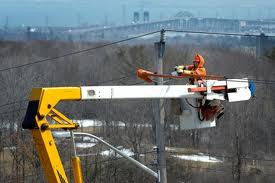 Hydro in Ontario has been broken for some time. It is essential that it be fixed – the solution is not yet clear, “If you have a billing complaint with hydro one, please make sure you file a complaint with the Ombudsman as he begins his investigation into Hydro One. Click here to file your complaint.
“And if you haven’t yet, please make sure you share your concerns about Ontario’s broken hydro system directly with the Premier, the Minister of Energy, the Ontario Energy Board and Hydro One.
The problem with the petition is its source. Randy Hillier was part of the government that created the problem we have today. Is the petition part of his drive to at some point lead the Progressive Conservative party in Ontario? His views and solutions to some of the provinces problems would take Ontario back to where Mike Harris put us and to where Tim Hudak wanted to keep us.
The province is going through a profound change; the core of its economic engine is threatened and in some cases fractured. General Motors is moving its assembly lines to Mexico.
The province faces a huge demographic shift; we are now a much more demographically diversified people and we have a growing seniors’ population that we have to care for at considerable cost.
Adjusting to these changes is going to take political leadership that looks forward and not backwards. Randy Hillier is as backward looking as you can get.
The petition has merit – the guy behind it; questionable.
A Petition to the Legislative Assembly of Ontario
To the Legislative Assembly of Ontario:
Whereas, the cost of electricity in Ontario continues to escalate;
And Whereas, other charges associated with electricity, such as delivery, regulatory, global adjustment and debt retirement charges make electricity increasingly unaffordable;
And Whereas, these costs have imposed a significant hardship on ratepayers and driven industry and jobs out of Ontario;
We, the undersigned, petition the Legislative Assembly of Ontario as follows:
That the Premier and the Minister of Energy reduce the waste and duplication in Ontario’s electricity sector and other necessary steps to lower the cost of electricity so that Ontario’s electricity prices are competitive with other jurisdictions.
Sign here:

 By Pepper Parr By Pepper Parr
December 11, 2014
BURLINGTON, ON
In 2013 the Burlington Age-Friendly Seniors Council created an audit that identified the strengths, gaps and barriers for Burlington being a truly Age-Friendly City. One of the recommendations from the audit was the overwhelming need for seniors to be able to access information in ways that they needed it.
Everything from health services, recreation, nutrition, transportation, volunteer opportunities, tax information and much more. The issues were identified by seniors and caregivers in Burlington and throughout Halton.
What seniors consistently had difficulty with was being put on hold or told to press 1 for more information or 2 for something else. They wanted to be able to talk to someone – have a face to face encounter – and get the information and help they needed.
 Heather Thompson, on the far right with the first class of Senior Ambassador Connectors were celebrated earlier this week. Paul Benson and Glenna Cranston are in wheelchairs in the front row, Heather Thompson, Manager of Corporate and Community Engagement at Community Development Halton thought the Burlington Age-Friendly Council could do something to improve the way information was given to seniors and family members, empowering them to make informed decisions. The need had been clearly identified; Thompson and her team had to find a way to meet it. They discovered a program called Senior Connectors at the Seniors Come Share Society in British Columbia.
They had a program that was delivering a service reaching seniors in a significant way.
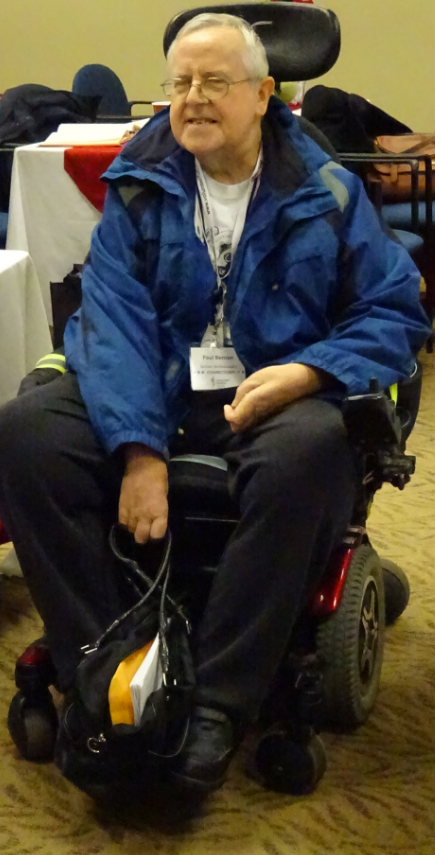 Paul Benson is a Senior Ambassador Connector because he has something to say and he wanted to learn so that he could help others. That was all Volunteer Halton needed to established the Senior Ambassador Program, where senior volunteers promote and talk to other seniors about the benefits of volunteering as people age, keeping them active, engaged and connected to their communities while making a difference. The Senior Ambassador Program consists of an Advisory Committee made up of members from each of four municipalities in Halton; Halton Hills, Milton, Oakville and Burlington.
Thompson and her colleagues met on Tuesday to celebrate the accomplishments of 10 volunteers who have completed the education and training component for the Senior Ambassador Connector Program. Volunteer Halton, a program of Community Development Halton, has been the lead on this initiative, with the Burlington Age-Friendly Seniors Council as a collaborative partner, working together to improve communication, information and resources for seniors and their families.
A grant from the Ontario Seniors Secretariat covered the start-up costs.
 Glenna Cranston hasn’t let her wheelchair get in the way of being a volunteer who helps other seniors dig out the information they need to live full lives. Acclaim Health, formerly known as VON, Victorian Order of Nurses, the Alzheimer’s Society, Burlington Public Library, Chartwell Retirement Residence, Community Care Access Centre – HNBH, ESAC – Region of Halton, Halton Geriatric Mental Health Outreach Program, Halton Regional Police Service – Salt, Seniors Help Line, Links2Care and Service Canada were among the organizations that came together to make this happen.
The training included: Mental health and aging, risk factors and where to go for help; Services available to seniors in Halton – housing, long-term care, supports to be able to live at home, volunteer visiting, support for caregivers, bereavement support, day programs for seniors with Alzheimer’s; Elder Abuse; Dementia and the importance of brain health; Eligibility for CPP, Old Age Security; Personal boundaries and volunteer opportunities
Monthly education sessions, case studies, and a continual update on new information will get done in 2015
Joan Gallagher-Bell, Ross Bell, Tracy Angus, Karen Phelps, Florence Riehl, Ellie Tyndall, Glenna Cranston and Carole Ward were part of the first set of Senior Ambassador Connectors.

 By Pepper Parr By Pepper Parr
December 9, 2104
BURLINGTON, ON
Marketing organizations and local governments want to know what you think.
In the case of the marketing types – we know their game – they want to sell us something.
With local government – the game isn`t the same. As far as they are concerned – you are already a customer and you aren`t going to the competition – because there isn`t any.
 Regional government offices at one end of the complex, Regional police at the other end. Halton Region creates a panel of 36 people each year and runs a series of questions by the panel,
The Regional government holds a “civic lottery” Lottery to find 36 local residents to form a Citizens’ Reference Panel. Invitations to form the panel were mailed to residents across the Region last week. Panel members will help determine which issues, services and programs matter most to the people who live and work in Halton.
Their insights, along with input from the broader community, will help the newly elected Regional Council develop a strategic work plan and set out priorities for the next four-year term.
Calling the Regional Council now in place “newly elected” is true but a bit of a stretch – of the 21 members of Regional Council only three are new to that level of government.
Same people – they will probably arrive at the same conclusions.
Regional Carr explains how the panel works. “Every four years Council works in consultation with stakeholders to gather feedback on the areas that matter most to Halton residents and businesses.
“Members of the Citizens’ Reference Panel have a unique opportunity to hear directly from Halton staff and local experts. Armed with a solid understanding of Regional services and processes, Panelists play an invaluable role in helping to shape the future of Halton Region.”
A Civic Lottery uses random selection to bring together groups of residents, balanced for age, gender and geographical location, to represent their community. Last week 10,000 letters were delivered to randomly selected households in the City of Burlington, the Town of Halton Hills, the Town of Milton and the Town of Oakville. Eligible candidates who receive the invitation can put their name forward for the Civic Lottery. The invitation can also be transferred to other members of the household. The 36 Panelists will be randomly drawn from among the respondents on January 8, 2015. The deadline for eligible candidates to enter the Civic Lottery is January 7, 2015.
 The Panel will meet over two full Saturdays on January 17 and January 31. The Panel will also meet on the evening of Wednesday, January 21 for a special Public Roundtable Meeting to which all Halton residents are invited. The Panel will meet over two full Saturdays on January 17 and January 31. The Panel will also meet on the evening of Wednesday, January 21 for a special Public Roundtable Meeting to which all Halton residents are invited.
Together, the Panelists will learn about the trends and pressures facing Halton Region as well as the services and programs the Regional government provides. As part of this process, the Region has prepared a draft Strategic Action Plan to serve as a starting point. The draft document will guide the discussion and assist in the development of specific, measurable actions that can be implemented over the next four years.
At the end of the process, working with expert facilitators, the Panelists will develop a series of informed recommendations to present to Regional Council.
Burlington uses a different approach – they put a survey on line and ask people to tell them what they like and don’t like in terms of the services the city provides for the tax money they pay.
Related article:
Burlington community survey

 By Pepper Parr By Pepper Parr
December 8, 2014
BURLINGTON, ON.
Your password has been entered incorrectly three times.
The message was concerning. Was the bank telling me that someone tried to get into my account electronically? It looked that way.
A message regarding “Password Disabled” has been sent to your account inbox
Secure. Click here To Enter Scotia on Line to avoid Access lock.
The moment you click on that link – you may as well have given them your wallet.
How would you know that? Look at the address the email came from. The word scotia is before the @. The words after the @ tell you that the domain name is not that of the bank.
 If the bank wants to communicate with you they will telephone or when there is a problem with your card the banking machine will keep the card and instruct you to go to a branch where they will issue another card. If the bank wants to communicate with you they will telephone or when there is a problem with your card the banking machine will keep the card and instruct you to go to a branch where they will issue another card.
On occasion you may get an email advising you that your withdrawal limit has been set at $1 – yes one dollar. They instruct you to go to a branch and get the problem resolved. It is very awkward when that $1 message shows up late Saturday evening – but it is better than having someone suck all your money out of the account.

 By Pepper Parr By Pepper Parr
December 9, 2014
BURLINGTON, ON
Hundreds of lines of news stories get written about pipe lines and the movement of oil across the country.
The National Energy Board sets the rules, the pipeline companies look for ways to make those rules less expensive to meet, the municipalities the pipelines run through worry about what an oil spill will mean to them and the average Joe wonders what it is all going to mean to them and look at the price of gas as they fill the tank.
 Route of the 40 year old pipeline that is going to have its flow reversed and used to carry toxic oil instead of natural gas. Why are oil prices so low now – what’s different? Something to do with supply and demand – so why do we need pipe lines to move oil when we already have enough?
It’s complex, confusing – but we know that if something goes wrong – we are going to have to pick up the tab.
Enbridge, the people who have a 40 year old pipeline that runs across the top of Burlington assures us that shutoff valves are not necessary to protect the creeks. The continuing conflict over more costly conditions being imposed on Line 9 by the National Energy Board is just one example of the push for greater municipal and provincial say about pipeline proposals including a massive cross-country project that would carry nearly four times more bitumen to export markets (video).
TransCanada’s Energy East proposal would convert a natural gas pipeline and extend it to carry 1.1 million barrels a day from the Alberta tar sands across northern and eastern Ontario to new tanker ports on the St Lawrence River and in New Brunswick. Like the two stalled pipeline routes across British Columbia, Energy East is facing a wall of opposition that now includes conditions imposed by Canada’s two largest provinces, and an environmental report that has now forced at least the temporary abandonment of the St Lawrence tanker terminal.
Where can we go to get an explanation we can understand.
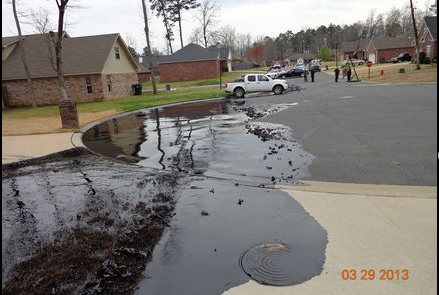 Toxic oil was running through the streets of Mayflower Arkansas in a pipeline most people didn’t even know was in place. Burlington groups want to make sure something like this doesn’t happen here. The Council of Canadians has created a video – Energy East 101 – kind of neat and loaded with information that can be verified. Click on this link – give it a listen. It is worth the time.
We know that climate change is already here; understanding how we can best adapt to it is where we need the help.

 By Pepper Parr By Pepper Parr
December 9, 2014
BURLINGTON, ON
The City of Burlington is asking Burlington’s property owners, business owners and renters to complete an anonymous online survey to tell the city what services matter most.
“We have identified all of the services the city provides and have refocused our budgeting to show citizens the investments we are making into each service,” said Joan Ford, the city’s director of finance.
“We are looking to the community for input on the importance and value of services.”
 Starting in 2015, the city is using a new system to budget and has 24 public services and 13 internal services to help provide efficient, effective services to the community. Those services include road and sidewalk maintenance, fire protection and transit. Starting in 2015, the city is using a new system to budget and has 24 public services and 13 internal services to help provide efficient, effective services to the community. Those services include road and sidewalk maintenance, fire protection and transit.
“The City of Burlington must make thoughtful choices among competing priorities to deliver good service for good value,” said Mayor Rick Goldring. “Using our Insight Burlington online community panel, and an anonymous survey connected to that panel, we hope to hear more about the services people in Burlington value.”
The Insight Burlington survey will take from 10 to 15 minutes to complete.
It is available from now until December 19 at www.burlington.ca/whatmatters.

 By Pepper Parr By Pepper Parr
December 8, 2014
BURLINGTON, ON.
Ontario’s Trillium Foundation (OTF) has bailed out Burlington Green to the tune of $375,000 over a five year term.
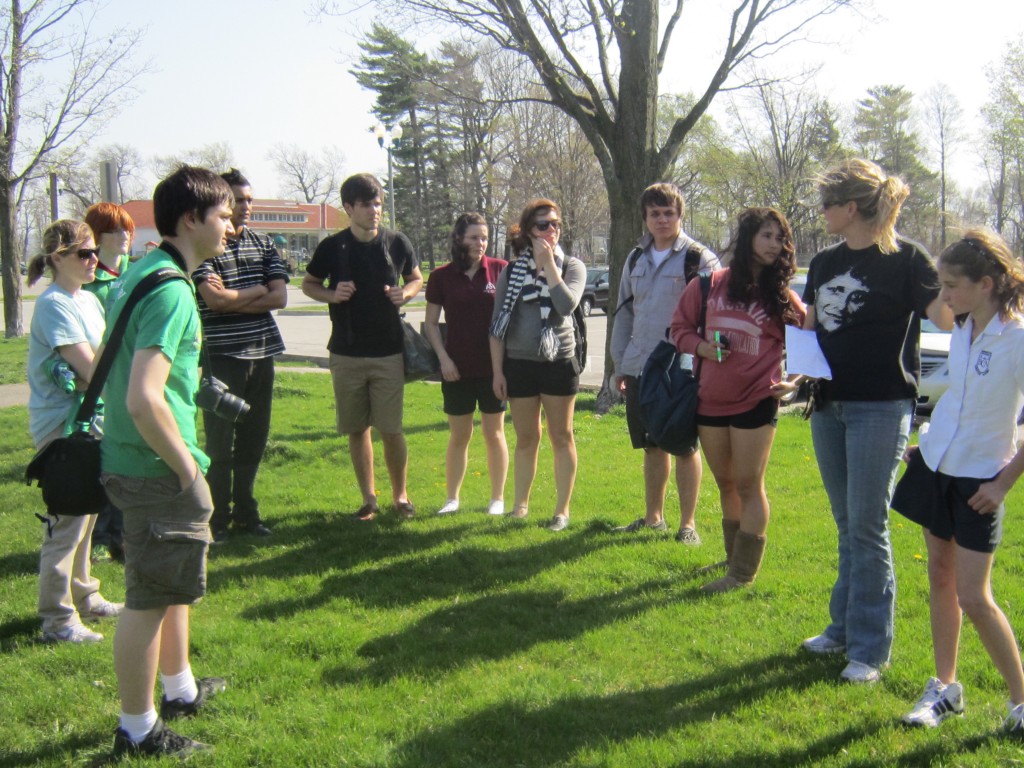 Burlington has led the effort to involve youth in environmental responsibility. The group is about to plant a couple of hundred trees. BurlingtonGreen, a volunteer driven organization striving to make Burlington a healthier more environmentally responsible city, has achieved numerous goals. The OTF grant will support current programming and provide funding to introduce two innovative community-based environmental initiatives.
The grant will fund approximately 50 per cent of the costs to provide a wide range of important environmental programs, services and events.
“Investing in effective, solution focused organizations like BurlingtonGreen is an investment in our collective future. Since their inception in 2007, the agency has engaged thousands of youth, citizens and groups in environmental learning while providing an array of rewarding and impactful volunteer opportunities that have benefited the health of the local environment,” said Eleanor McMahon, MPP for Burlington.
BurlingtonGreen’s Board President Paul Haskins commented on how vital the funding support is in strengthening the agency’s capacity to plan more effectively and strategically for a more sustainable future.
“It has become an increasing challenge for our agency to keep up with the wide range of demands that come our way as pressures on the environment continue to escalate and the implications of climate change become more evident at the local level,” said Haskins.
 BurlingtonGreen Executive Director Amy Schnur with the bike that was donated by the Mountain Equipment Co-op as art of the drive to increase votes for the Call of the Wild $100,000 contest. Grant funds will be used to support the delivery of children and youth programming, to co-ordinate the biennial Youth Eco-Summit and Eco-Awards Celebration, continue their innovative Grow to Give food donation service, to continue to conduct the popular city-wide Clean Up event and habitat restoration project work.
New initiatives include collaborations to create a Burlington focused eco-footprint calculator to help citizens, schools, community groups, and businesses understand their current impacts on the environment, highlighting opportunities to realize positive measurable change as well as efforts to establish a Green Building Demonstration Project.
Burlington took a huge environmental hit in August when rain storms flooded parts of the city and significantly damaged hundreds of homes. Everyone involved in policy in this city now uses the phrase “not if but when” the next environmental disaster strikes but we don’t seem to get much beyond that phrase.
BurlingtonGreen has done a brilliant job of attracting environmental stars to the city and developing a sense of environmental responsibility in the hearts and minds of high school students. Is there a place, an opportunity for BurlingtonGreen to begin the conversation within the community as to how we might protect ourselves and prepare ourselves for that next disaster?
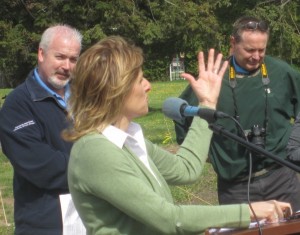 Amy Schnur, current executive director of BurlingtonGreen now has an opportunity to go further with the development of policy proposal and provide some much needed intellectual leadership. Picking up the waste and planting new trees are a major part of being more environmentally responsible and BurlingtonGreen does this well. Now that they have funding in place for the next five years, something very few non-profit organizations are fortunate enough to get; the community can rightfully ask them to step up their game and provide some policy leadership – because it isn`t going to come from city hall, the region or the Conservation Authority.

 By Pepper Parr By Pepper Parr
December 5, 2014
BURLINGTON, ON.
Shelley Raymond had a problem – both her parents were at that point in their lives when they needed a level of care she had not had to provide in the past.
Her Mother’s Alzheimer’s was advanced and her Father’s dementia while stable, made life demanding for her.
Where do they live when they can no longer care for themselves? There is nothing comfortable about the choices people like Shelley Raymond have to make.
 Seniors will represent more than 25% of the population of Burlington in the not too distant future. More than 14% of Canada’s population is over 65 and that number is going to grow – the Baby Boomers are moving into retirement.
Long term care is one option. According the Ms Raymond, a senior today has a 7% chance of getting a long term care bed,
 Will Burlington be properly prepared for the growth in the seniors population? Staying home, alone is the choice many make – but it doesn’t work. The isolation leads to depression; memory loss creates all kinds of problems – medication isn’t taken; repairs on the house just don’t get done; there are challenges with food preparation and falling down stairs or tripping over objects is very common.
Many, including Shelley Raymond believe the province faces a long term care crisis.
Seniors need some level of support for daily living activities – cooking, cleaning, shopping, transportation and medication reminders. Most seniors want to remain independent as long as possible; many try to remain independent and do themselves considerable harm both emotionally and financially.
 A vital and pressing problem for a lot of families in Burlington. Finding the level of care parents need is just one part of the problem – being able to pay for that care is the second part. The over-riding question is – how long will the money last?
What’s available in terms of care? Long term care facilities: $78 a day – $2400 a month for a private room; $56 a day for basic care – $1707 a month.
 Depressing and scary – is this the best the province is going to be able to do? Retirement homes come in at $3500 a month and can run up to $8000 a month with advanced services. These are now growth businesses. The Pearl at Pine is preparing to open seen, the six floor residence on Upper Middle Road next to the Tansley Woods community centre has been open for more than a year and Aldershot has a new retirement community.
The other options are staying in your home or moving in with family.
For those who choose to stay in their homes there is an additional issue and that is home care offered by the province’s Community Care Access Centre (CCAC). There are limits to the number of people they can handle – the number of senior’s that will need care is not as limited. There is a crunch coming.
There are literally tens of thousands of seniors facing this problem – and they are beginning to realize that the government is not going to solve their problem for them. People are coming up with good ideas – that’s what Shelly Raymond had to do when her parents needed care.
Remember that television program The Golden Girls – they are on the way back. Sharing accommodation was an entertaining idea – Shelley Raymond took it a couple of steps further and developed the idea of what she calls “co-housing”.
 Top house was renovated to become a cohouse. Bottom was purpose built to be a cohouse. She created an organization called Solterra that works with people who want to be part of a co-housing property. She looks for properties that can be used, works with architects to build the homes, markets them and then works with owners to get them set up with the services they want and need. Much more information on their web site. Tell Shelly you read about her in the Burlington Gazette.
People share the ownership of a building. Each resident has their own private space and share common space – kitchens, living room and perhaps gardens.
 Floor plan for a six unit cohouse. Typical “co-houses” have four to six owners. Each owner has title to their portion of the house which can be sold on the open market. They share the taxes, the heating and electricity, maintenance.
 The kitchen area of a cohouse in Brechin Ontario There is also the potential to share household services as well – which many of the cohousing operations do. Someone comes in and does the cleaning; some have a person who comes in and does the cooking and meal preparation. There are various levels of service that are possible. The owners decide what they want and can afford.
Most of the units have small walk outs to a private yard in some cases or a common area in others. Parking, transportation – and what about pets.
The basic rule is usually no pets but the owners of the units are the “board of directors” and they can make any decision they like. “One cohousing operation voted to try a pet for a short period of time” explained Raymond. Sally, the dog is now the star of that house and has put in twenty pounds.
The biggest part of co-housing is the “co” part – decisions are made in common and people fashion the kind of community they want.
 Owners bring their own furniture and set up their home the way they want. How does one know that cohousing will work for them? Most of the cohousing organizations have a three month trial period. You move in – you pay “rent” and try it out. If you find that the people are your kind of people and the level of service is what you need – then you can buy your share of the house.
What are the advantages of cohousing? Financially they are incredible. Heating, electricity, taxes, maintenance are all shared by the people living in the home. And those people are not residents – they are the owners. The difference is that they share the ownership of the property. The house is not a nursing home – it belongs to the people who live in it.
They are purchasing a percentage interest in a home, freehold that is individually saleable on the open market, registered on title as Tenants in Common. It is a private residence in which you maintain your privacy and control
The Burlington Community Foundation recently published their third Vital Signs report in which they said “There will be greater emphasis on shifting care to the community and supporting aging in place. Home Care and Community Support Service agencies will support more elderly people with complex and often inter-related health and social care needs to remain in or return to their homes, especially after a hospitalization.
The report suggested Coordinated Care as an approach that will bring together patients, teams of health professionals including specialists, community partners, to ensure not only a positive health outcome but also a quality of life outcome for patients.
If current trends persist, there will continue to be a shortage of long-term care beds and this will result in more seniors staying in their homes out of necessity rather than personal choice and need. The hope is that substantially more spaces in long-term care homes will be created so that waiting lists and wait durations get smaller rather than larger.
 The layout, scope and size of a cohouse is limited only by the imagination of the developers ad the people who want to live in these homes. Neighbourhood planning and building design will take into account the accessibility needs of seniors both in terms of mobility and to reduce the isolation of seniors. This will continue as part of the movement to develop age-friendly communities; something we have not heard very much from the Planning Department.
 This is what cohousing is all about. It is one of the more imaginative and financially viable ideas to come along in some time. And that is exactly where Shelly Raymond is going with her Solterra concept.
When she spoke recently in Burlington there were a number of women in the room who met with her after and asked – “How can we do this now?”

 By Staff By Staff
December 4, 2104
BURLINGTON, ON.
A house ablaze Christmas Day is terrifying – and it happens all too frequently. People are careless, the electrical system is overloaded or something gets bumped off the stove and there is a sudden fire.
The Burlington Fire Department is offering residents some simple fire and life safety tips that will keep families safe during the winter holiday season.
 This is not where fire fighters want to be anytime – and certainly not during the holidays. “This is the time of year when we see an increase in fire-related risks. Many people don’t realize that some decorating materials can be extremely flammable,” said Joe Wintar, chief fire prevention officer. “Consider opting for safer alternatives for lighting like battery operated candles.”
With the arrival of winter weather, residents are reminded to help keep homes and workplaces clear of snow.
“Having unrestricted access to your home in the event of an emergency is very important,” said Wintar. “Clearing snow buildup away from hydrants, house numbers as well as vents on the outside of your home are a just few ways to stay safe during heavy snowfall.”
A fire hydrant in front of one home may protect properties on either side of the street. Wintar says neighbours should consider sharing the responsibility of clearing the hydrant. Residents are also encouraged to ensure house numbers are visible, especially in the rural areas where there can be blowing snow. It’s always advisable to check in on elderly or disabled neighbours to help with snow removal.
Here are few simple tips to follow to keep your home winter-safe:
Ensure the fire hydrant is clearly visible for approaching emergency vehicles and maintain a one metre clearance for firefighter access.
Clear snow away from exterior doors and stairways to allow for a quick and safe emergency exit
Prevent snow and ice from gathering on outside meters to give access for emergency and utility workers.
High and medium-efficiency furnaces and water heaters have vents that exit the building through outside walls rather than through the roof. Keep vents clear, as carbon monoxide can build up inside your home if the vents are blocked.
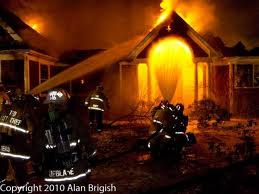 A house on fire on Christmas Day – a true tragedy. Note quite the Twelve Days of Christmas but certainly 12 Days of Holiday Fire Safety tips:
1. Water fresh trees daily.
2. Check all lights before decorating for wear and compatibility.
3. Make sure you have working smoke alarms.
4. Make sure you have working carbon monoxide (CO) alarms; As of Nov. 1, it’s the law.
5. Have, and practice, a fire escape plan so everyone knows how to get out safely.
6. Use extension cords wisely.
7. Give space heaters space, and keep them away from surfaces and anything that could catch fire.
8. Go flameless and use flameless candles.
9. Keep matches and lighters away from children.
10. Keep an eye on your cooking. Stay in the kitchen and pay attention.
11. Ask smokers to smoke outside.
12. Alcohol and fire don’t mix. If you’ve been drinking, avoid smoking and cooking.
The Burlington Fire department wants you and your family to have a happy, safe holiday. They expect Santa to be visiting your home – they do not want to have to visit your home.

 By Pepper Parr By Pepper Parr
December 4, 2014
BURLINGTON, ON
For those parents that use day care – the decisions that have to be made are both emotional and financial.
For many – the cost of day care is close to prohibitive – and then there is the quality of the day care.
News reports of children in day care actually dying – and it does happen – frighten parents. For those with limited incomes the choices are not all that good.
 The joy of watching a child figuring something out – in a safe environment. The province of Ontario has introduced legislation that will provide over sight for unlicensed day care.
The legislation will strengthen oversight of the province’s unlicensed child care sector and increase access to licensed child care options for families. In addition, it will allow the province to immediately shut down a child care provider when a child’s safety is at risk.
The Child Care Modernization Act also:
Gives the province the authority to issue administrative penalties of up to $100,000 per infraction by a child care provider.
Increases the maximum penalty for illegal offences under the act from $2,000 to $250,000.
Increases the number of children a licensed home-based child care provider can care for from five to six.
Clarifies what programs and activities are exempt from licensing requirements, including care provided by relatives, babysitters, nannies and camps that provide programs for school-age children.
Requires all private schools that care for more than five children under the age of four to be licensed as a child care centre.
Amends the Education Act to ensure school boards offer before- and after-school programs for 6 to12 year-olds where there is sufficient demand.
 Activities that keep them busy and learning at the same time. Is this the first step to getting into poker games? The legislation builds on steps that Ontario has already taken to improve oversight of child care. This includes the creation of a dedicated enforcement team to investigate complaints against unlicensed providers, as well as an online searchable registry – paired with a toll-free number – to inquire about unlicensed child care violations.
It is another layer of government that will have to be paid for by the government. There was a time when there was pressure to create a Canada wide day care service with subsidies. The province has a service that started out costing $5 per day per child. Ontario has never flirted with that kind of an idea.
Ontario has 5,069 licensed child care centres in the province with a total capacity of 317,868 spaces; 166,429 of those spaces are in publicly funded schools.
 Keeping them safe and ensuring that they can be outside getting fresh air and exercise is the objective. Keeping the costs bearable is the challenge. Starting in 2014-15, the government is investing an additional $33.6 million, over three years, to support the ongoing operation and modernization of the child care system –protecting the gains made through the previously announced investment of $346 million over four years.
Additional information:
Four steps to finding the right child care

 By Staff By Staff
December 2, 2014
BURLINGTON, ON.
Watch sculpting master Michael Muli use various techniques to transform ice into art at the Royal Botanical Gardens.
 A master ice sculptor will be at the Royal Botanical Gardens December 6thand 7th. No to be missed. Michael is creating an enormous 3D tribute to the RBG Train Show for kids to climb aboard. You can drop by and get your picture taken with the kids.
Be sure to stop by and get your photo taken with the final piece before it disappears!
Event takes place from December 6 (1 p.m. to 5:30 p.m.); December 7 (10 a.m. to 4 p.m.)

 By Staff By Staff
November 28, 2014
BURLINGTON, ON.
Are you a teen in the Halton Region who would like to understand more about the Police, Ethnicity and Culture (PEACE) in our communities?
Are you interested in a career in policing?
Have you ever wondered what the police do, how they prevent and investigate crimes and what the different units within the service are responsible for?
Would you like to have hands-on practical experience of what it’s like to be a police officer?
 If you are 15 – 18 years old and the answers to these questions are yes, maybe you’d like to check out the Halton Regional Police PEACE program! If you are 15 – 18 years old and the answers to these questions are yes, maybe you’d like to check out the Halton Regional Police PEACE program!
There are still spots available for the Winter Police Ethnic and Cultural Education (PEACE) program, which runs from 6:30 – 9:00 pm every Tuesday night for twelve weeks, starting January 20, 2015 and April 7, 2015.
Each week, students will be given presentations by the different units and bureaus within the police service, with the emphasis being on practical demonstration and involvement. As well, students will learn about cultural awareness and inclusion, how the police service strives to provide equitable service for all communities within our Region and how we are educating new Canadians and recent immigrants about policing in Canada.
You can find out more about this free, voluntary program by visiting our website and clicking on Diversity.
Just complete the application form on line and Email it to the Diversity Coordinator at the contact information on the form.

 By Staff By Staff
November 25, 2014
BURLINGTON, ON.
 Bring your pen and pad, come with some ideas or just ready to write. Bring your pen and pad, come with some ideas or just ready to write.
Prompts will be provided, sharing is requested, but not mandatory.
All writing styles welcome, ages 12 and up.
This workshop is provided for FREE, but donations are accepted.
Thursday – Tansley Woods Library 7-9

 By Pepper Parr By Pepper Parr
November 24, 2014
BURLINGTON, ON.
He left us on this day in 1807. Sometime after his community transported his remains to Brantford where he is celebrated and revered.
Burlington was the location of the land grant Joseph Brant was given for his service to the British Army during the American Revolutionary wars.
 Joseph Brant was a part of making Canada what it is today – he just isn’t adequately recognized for his contribution. The city is littered with the history of the land transfers that piece by piece transferred every acre from Joseph Brant to other people in Burlington. The Kerns family was the first to buy property from Brant – 200 acres on the east side of Brant Street.
Each August the city holds an event at the LaSalle Park and Joseph Brant does get a mention.
The Board of the Brant Museum on Lakeshore Road has elaborate plans for a modern display telling the Brant story and the copy of the original Brant home will be part of the structure but the public won’t be able to actually go into the building – that will be used for “administrative” purposes.
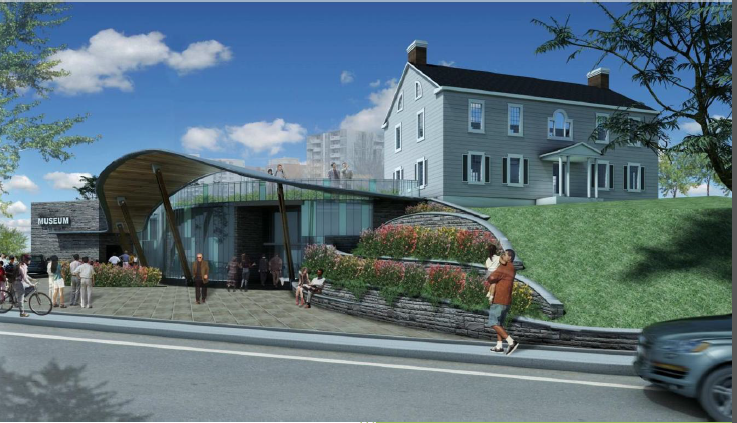 Architect’s rendering of what a “new” Joseph Brant Museum might look like. It would be built on an intersection that will become one of the busiest in the city when the re-developed hospital opens in 2018/19 Poor Joseph Brant – we keep short selling the man and his exceptionally significant achievements.
There is hope. Rick Wilson, the man who corrected a major error in historical fact when he pointed out that an historical sign on the Burlington Heights side of Burlington Bay was incorrect when it described a War of 1812 battle.
That error got corrected and there is now a piece of signage that sets that story straight. Wilson has some thoughts that he hopes will result in the creation and erection of a suitable statue of Brant.
There is hope.
Related stories:
Citizen finally gets the province to recognize their error.
Signage goes up telling the true story of the Burlington Races.

 By Pepper Parr By Pepper Parr
November 24, 2014
BURLINGTON, ON
It was a four event opening at the Art Gallery of Burlington as well as the announcement that Christopher Reid Flock had won the very prestigious Winnifred Shantz ceramics award for his recent ceramic work.
 Christopher Reid Flock’s award winning ceramic. Flock has been reinterpreting the root of functional objects, focusing on aesthetic contrasts and parallels between Japanese and Canadian cultural history. By exploring scale, colour and the integration of mixed media, his works have evolved into free-form shapes and sculptural constructions that evoke recognizable and classic references of traditional Japanese Ikebana arrangements and kimono-wrapping while combining aspects of western industrialization.
The Clay & Glass presents these awards to practicing early career artists who have worked professionally for fewer than 10 years prior to the date of application. The Award is intended to allow the artists to undertake a period of independent research or other activities with the goal of advancing their artistic and professional practice at a key moment in the artist’s career.
Flock began working with clay when he was 23 at the then Burlington Arts Centre. He began his career as a student studying violin and came to the realization that clay was his medium and the violin became a thing of the past.
Denis Longchamps, Director of Program for the AGB was like a proud parent when he made the announcement at the opening Sunday afternoon.
The piece that won the award is on display at the former Fireside Gallery.
 Debra Kuzyk’s ceramic skunk The four openings included Scavengers, Scoundrels and Urban Vermin; a collection of Debra Kuzyk’s ceramic work; the photography of Janusz Wrobel; the monochromatic watercolour abstractions of Warren Hoyano and the display of the award winning Flock ceramic.
Janusz Wrobel was once loaned a camera and given a couple of rolls of film, the current state of that journey was on the walls of the AGB and called “An Aqueous State”
 Janusz Wrobel : “Sweet Water Sea” Wrobel said he wasn’t trying to communicate anything specific with this exhibit but adds that he “came to believe that in our civilization, environmental predicaments could be effectively addressed only by a change of mindset by a vast majority of us.”
The locale for the photographs in this exhibit is Georgian Bay; the work of Tom Thomson and the Group of Seven are an admitted influence.
Warren Hoyano is on the other side of the Lee Chin Family Gallery.
The decision to put the two artists in the same gallery was a curatorial stretch on the part of AGB Director of Program, Dennis Longchamps and yet it works. Moving from the side of the room where Wrobel’s “Evening Amber” is displayed and crossing over – some 30 feet, to where Hoyano’s “Ache” is displayed is certainly a jump.
Not a startling one – but not one you expected to make. It isn’t jarring – but it does stretch you and that is part of what art is supposed to do for us.
In the “This Pocket of Deeds”, Hoyano, a self-taught artists, explores a known shape, the heart and overlaps it with script and gestural marks.
 One piece from the Warren Hoyano, “This Pocket of Deeds exhibit at the Art Gallery of Burlington While love is often associated with the heart shape, Hoyano chose “Void” to engage the viewer on a different trajectory.
Both artists are on display at the AGB until January 25th.

 By Staff By Staff
November 19, 2014
BURLINGTON, ON
No one ever went wrong talking about energy saving – especially when the temperature outside was double digit below and when our friends in Buffalo were getting more than two feet of snow.
Burlington’s Sustainable Development Committee will host a free event on Nov. 25 for homeowners to help reduce home energy costs.
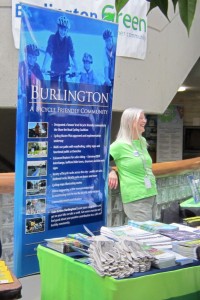 Lynn Robichaud, the city’s senior sustainability coordinator takes part in almost every environmental event in the city – heading up the energy efficiency seminar later this month. Takes place Tuesday, Nov. 25 from 7 p.m. to 9 p.m. at the Burlington Public Library, Central Branch, at 2331 New St.
“Homeowners can learn valuable cost-saving tips to make their home more energy-efficient,” said Lynn Robichaud, the city’s senior sustainability coordinator. “Industry experts will be on hand to answer questions.”
Participating organizations include: Burlington Hydro, GreenVenture, Halton Region, Philips Lighting and Union Gas.
In 1990, the City of Burlington declared itself a Sustainable Development Community and set up the Sustainable Development Committee as an advisory body to City Council.
The role of this volunteer citizens’ committee, which includes members of the public and the business community, is to get people talking about sustainable development and to integrate economic and environmental planning at the municipal level.

|
|
 By Pepper Parr
By Pepper Parr


































 The Panel will meet over two full Saturdays on January 17 and January 31. The Panel will also meet on the evening of Wednesday, January 21 for a special Public Roundtable Meeting to which all Halton residents are invited.
The Panel will meet over two full Saturdays on January 17 and January 31. The Panel will also meet on the evening of Wednesday, January 21 for a special Public Roundtable Meeting to which all Halton residents are invited.  By Pepper Parr
By Pepper Parr If the bank wants to communicate with you they will telephone or when there is a problem with your card the banking machine will keep the card and instruct you to go to a branch where they will issue another card.
If the bank wants to communicate with you they will telephone or when there is a problem with your card the banking machine will keep the card and instruct you to go to a branch where they will issue another card.


 Starting in 2015, the city is using a new system to budget and has 24 public services and 13 internal services to help provide efficient, effective services to the community. Those services include road and sidewalk maintenance, fire protection and transit.
Starting in 2015, the city is using a new system to budget and has 24 public services and 13 internal services to help provide efficient, effective services to the community. Those services include road and sidewalk maintenance, fire protection and transit.




















 If you are 15 – 18 years old and the answers to these questions are yes, maybe you’d like to check out the Halton Regional Police PEACE program!
If you are 15 – 18 years old and the answers to these questions are yes, maybe you’d like to check out the Halton Regional Police PEACE program! Bring your pen and pad, come with some ideas or just ready to write.
Bring your pen and pad, come with some ideas or just ready to write.













